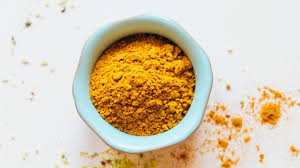
Curcumin is a bright yellow chemical produced by plants of the Curcuma longa species.
It is the principal curcuminoid of turmeric (Curcuma longa), a member of the ginger family, Zingiberaceae.
It is sold as a herbal supplement, cosmetics ingredient, food flavoring, and food coloring.
Laboratory and clinical research have not confirmed any medical use for curcumin.
It is both unstable and poorly bioavailable.
It is the isolate yellow coloring-matter from the rhizomes of turmeric.
Its applications are as an ingredient in dietary supplement, in cosmetics, as flavoring for foods, such as turmeric-flavored beverages, and as coloring for foods, such as curry powders, mustards, butters, cheeses.
Appearance as bright yellow-orange powder.
Its potential for medicinal properties remains unproven and is questionable as a therapy when used orally.
Annual sales have increased because of its popularity as a dietary supplement, and is increasingly popular in skincare products that are marketed as containing natural ingredients or dyes.
Curcumin reacts with boric acid to form a red-colored compound, rosocyanine, and exhibits interference properties which may lead to misinterpretation of results.
It has a hydrophobic nature, and is poorly soluble in water.
It is easily soluble in organic solvents.
Has chemical instability, water insolubility, absence of potent and selective target activity, low bioavailability, limited tissue distribution, and extensive metabolism.
Very little curcumin escapes the GI tract and most is excreted in feces unchanged.
It interacts with several proteins known to increase the risk of adverse effects, including hERG, cytochrome P450s, and glutathione S-transferase.
It may interact with prescription drugs and dietary supplements.
In high amounts, it may be unsafe for women during pregnancy.
Has poor bioavailability, is rapidly metabolized, retained low levels in plasma and tissues, and is extensively and rapidly excreted, factors that make its in vivo bioactivity unlikely and difficult to accurately assess.
Has chemical instability, water insolubility, absence of potent and selective target activity, low bioavailability, limited tissue distribution, extensive metabolism, and potential for toxicity.
Reduces circulating C-reactive protein in human subjects.
It may cause side effects, such as nausea, diarrhea, hives, or dizziness.
Studies in cancer patients consuming high doses of curcumin (up to 8 grams per day for 3–4 months) showed no toxicity, though some subjects reported mild nausea or diarrhea.
The intended use of curcumin as a food additive is generally recognized as safe by the U.S. Food and Drug Administration.
It has no medical uses established by well-designed clinical research.
Curcumin, the main component of turmeric rhizome, inhibits Na+–K+-ATPase and helps regulate CSF production.
